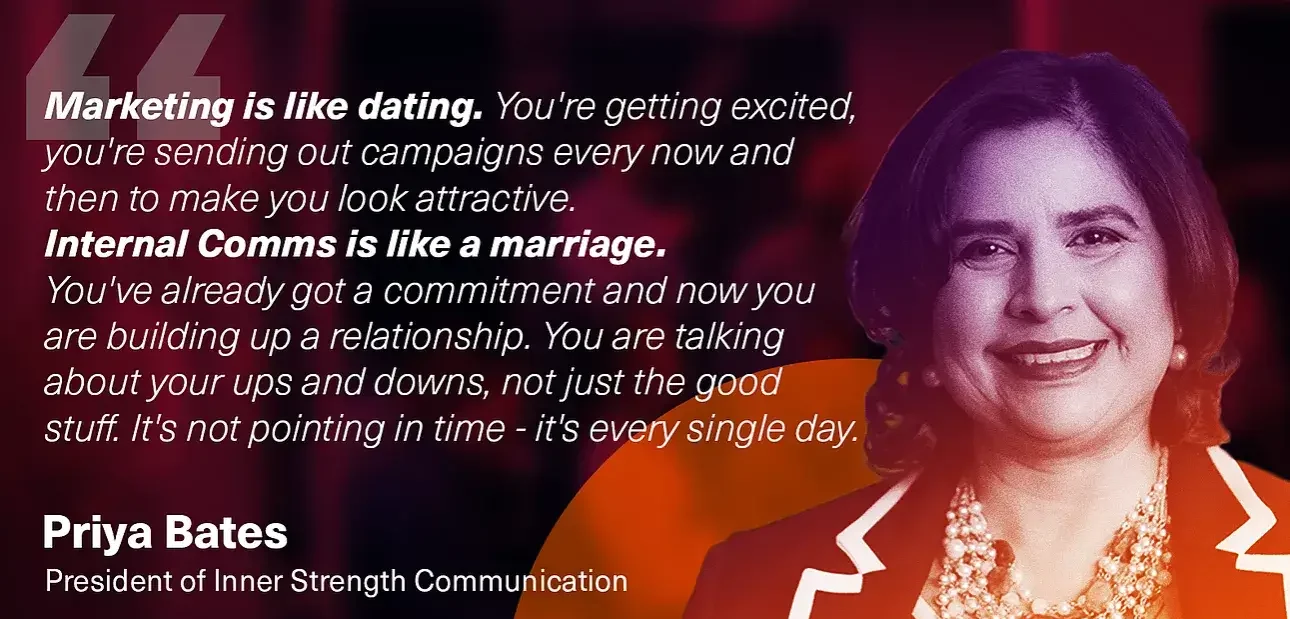Business communication is the secret ingredient to driving engagement within and outside the organization. So, how to get it right?
Business communication is the lifeblood of all organizations. Without a great business communication strategy in place, it becomes extremely challenging — if not impossible — to improve employee engagement and retain your customers.
At the end of the day, it’s your business’s success that may suffer from poor business communication! And that’s because business communication is the key to building a strong community around the brand.
📚Before we move forward, check out our blog on Employee Communications!
Indeed, communicating with your employees and customers doesn’t mean sharing information about your product or your business with them. Instead, it means enhancing dialogues, inspiring them, and building a connection with the brand.
We share in this post some of our business communication best practices for driving engagement inside and outside your organization. We hope you find it useful!
Get a demo now and see the benefits of an IC tool for your business
What Is Business Communication?
Business communication is the exchange of information between several parties concerning business activities.
The messages may cover different topics, from product features, the launch of a new service, the company’s culture, employees, the company’s vision and strategy, or its mission statement.
The Golden Rule: Your Business Communication Should Be Goal-Oriented
When it comes to business communication, the key is to build a goal-oriented strategy. It’s one of the best ways to align employees with the company’s vision and long-term strategy.
For example, when you craft your internal communication, your final goal is not to share information internally to keep employees informed about the business. Instead, your goal is to help your employees get the information they need when they need it — including the company news mentioned earlier — so they can be successful in their daily jobs and support the company’s growth.
Because your business communication strategy is goal-oriented, you’re going to build specific communication campaigns that will help the organization reach the objectives originally set.
Your communication campaigns won’t be the same whether your business goals are to improve employee experience, attract talent, strengthen the company culture, or successfully change your brand messaging.
Related: 11 Reasons Why Business Communication is Critical to Your Company’s Success
Internal and External Business Communications
When it comes to business communication, you share messages with your internal audience — basically your employees — as well as with your external audience, including your customers, suppliers, investors, and journalists.
Internal Business Communication
Internal business communication is the cornerstone of every organization. It includes the exchange of information within the organization and all the discussions going on between employees, managers, team leaders, and top management.
But internal business communication is not limited to peer-to-peer communication, it also includes team communication and it’s the secret sauce ingredient to breaking down silos in the workplace.
Building a great internal business communication is a top priority for most businesses, but the current state of internal comms is alarming:
- Only 43% of leaders focus solely on internal communication and employee engagement
- 60% of companies don’t have a long-term internal communication strategy in place
- As a result, 74% of employees have the feeling they’re missing out on important information and only 13% are engaged at work
- 72% of employees don’t have a full understanding of the company’s strategy
- 28% of leaders report poor communication as the primary cause of failing to deliver a project within its original time frame
- Only 17% of employers think line managers are good communicators
- Just 40% of IC professionals believe that employees understand “well” or “very well” the contribution they’re making to their organization’s strategy
And the list goes on…
It’s your business overall that may suffer from poor internal communication. Basically, your internal business communication has a direct impact on:
- Employee productivity
- Collaboration in the workplace
- Teams’ success
- Employee experience
- The company culture
- The ability to drive innovation in the workplace
- Employee engagement
- The ability to attract and retain top talent
- The business’s growth
- The company’s success overall.
Want to learn more? Check out our post 10 Shocking Internal Communications Stats You Can’t Ignore where we’ve compiled the most astonishing internal comms stats.
The Era of Digital Communication
When it comes to internal business communication, the key is to connect employees through digital channels.

The workplace landscape is changing at a rapid pace and one of the best ways to cope with it is to adapt the way you communicate with your employees to their habits and expectations.
Think about it: today, more than half of the employees work remotely in the US. Accenture states that by the end of next year, 43% of the workforce will be freelance. What’s more, millennials will make 75% of the US workforce by 2030.
So, how do you connect with your employees?
The secret lies in the communication channels you’re using for your internal business communication.
Building an effective internal communication is all about sharing the right messages with the right employees at the right time and through the channels they prefer — digital channels.
External Business Communication
Your external communication is as important as your internal communication strategy.
The messages you share with your external audiences and the way you share them has a direct impact on the way your brand is perceived by the public and your customers.
The Power of Word-of-Mouth in Business Communication
Building a robust brand reputation may take years if not decades, but destroying it may take only a few seconds. Welcome to the era of social media!
Even though your brand has fellow fans, it may also have haters. That’s the harsh truth about social media.
But the good news is, the way you communicate may change it. And guess what? Your employees can help you with that. That’s the power of word-of-mouth!
According to Nielsen, only 33% of buyers trust brands while 90% of customers trust recommendations from their peers.
What’s more, Edelman Trust Barometer found that employees are more trustworthy than chief executives when it comes to business communication.
And these stats are not surprising. Indeed, we tend to trust more easily people “like us” than business leaders whose one of their top missions is to protect the brand, its reputation, and its financial health.
More and more businesses are understanding the key role of employees in external communication and are giving them a voice.
Business Communication Is Even More Critical in Crisis and Change Management
Business communication’s role in the company’s success is even more critical in times of crisis.
A picture that you post on social media, a scandal that involves the brand, or an advertising fail can escalate into a full-on crisis before you know it.
The messages you share with your audience will have a great impact on the ability of the brand to recover from the crisis.
But business communication also plays a key role when the company is undergoing a change that involves restructuring such as a merger or an acquisition.
The way you communicate the merger with your employees will obviously have a great impact on the success of the merger or the acquisition.
But don’t overlook your external audiences during a merger! Silence leads to assumptions and rumors that may permanently harm your business.
Business Communication Is the Secret Ingredient to Driving Employee & Customer Engagement
Like in any other kind of relationship, communication plays a critical role in the relationships you build with your employees and your customers.
We’ve hosted a webinar called “The great Comms Debate” where Priya Bates, President of Inner Strength Communication, Jason Anthoine, Managing Founder of Audacity, and Mike Klein, Principal at Changing the Terms, shared their thoughts on internal communications trends that are reshaping the workplace.
I personally like Priya’s analogy: “Marketing is like dating” and “internal comms is like a marriage”. Indeed, the way you communicate with your employees and your external audiences will have a direct impact on your ability to retain top talent and keep your clients.

Think about it: business communication is all about driving engagement. Keeping your employees and external audiences informed about the business is a good start, but it’s not enough.
Communicating doesn’t mean sending out messages. Instead, it means exchanging information, driving discussions, and inspiring action.
As a communicator, one of your top priorities is to nurture long-term relationships with your employees and your customers. And to do so, you need to inspire them, connect them with your brand, and generate emotions.
But building a great business communication doesn’t come easy. It takes time and effort to improve employee engagement and keep your customers loyal.
10 Best Practices for Driving Engagement Through Great Business Communication
We share bellow tips and best practices for driving engagement through great business communication. And the cool thing about these best practices is that you can use them in different contexts: during a crisis, when your company is undergoing a merger or acquisition, or when you’re about to launch a new product.
Are you ready? Let’s dive in!
1. Don’t Sugarcoat Your Messages. Tell the Truth
If you want to build long-term relationships with your employees and your external audiences, one of the first things you’ll have to do is earning their trust.
And that’s not going to be an easy task: today, 96% of consumers don’t trust ads. What’s more, a recent survey by TeamBlind found that in some companies, up to 80% of employees don’t trust HR. Ouch!
So, what does that mean for your business?
Simply put, it means that you need to build an open and transparent business communication. No matter what happens at the company, you need to inform your audiences and drive discussions with them.
In times of crisis, don’t try to make things look better than they are. Information will start leaking anyway, so you may want to be proactive and tell the truth before your employees and your customers start making assumptions that turn into rumors.
Related: Crisis Communication — How to Communicate with Employees During a Crisis?
But your customers don’t want to hear about your business only in times of crisis! They want to learn about your vision, your core values and the social causes your company supports.
The same goes for your employees: they want to understand the company’s north star metric, your strategy overall, and how their jobs contribute to the business’s success.
Keep in mind that business communication is an on-going process. Don’t open up only in times of crisis — keep the discussions going on. It’s the only way to build a solid brand!
2. Communicate Complex Situations in a Simple Way
Don’t get me wrong — being transparent doesn’t mean sharing with your employees and external audiences long presentations, financial reports (that no one is going to read), or unengaging activity reports!
Neither your customers or employees like business jargon. And let’s be honest, they don’t have time for that!
Think about it: employees spend more than 25% of their time searching for the information they need to be successful in their jobs. So you need to keep your messages short and sweet!
The key here is to repurpose your content. Turn your reports and presentations into videos, infographics, or short posts that your employees and customers (if you share your reports externally) can easily digest.
Remember, infographics, images and videos are processed by the human brain 60,000 times faster than text!
3. Don’t Share Messages. Enhance Dialogues!
The thing is, your employees’ and customers’ expectations have changed. They don’t want to have a passive role in your business communication, they want their voice to be heard.
They don’t expect you to share messages with them. Instead, they want to join your community and share their own messages and thoughts with the other members of your community.
The old days of one-way communication where top management would communicate the messages they want with the employees and the customers are over!
Most businesses are turning their communication strategies into dialogues. They organize poll surveys, focus groups, and one-on-one sessions to collect employees’ feedback and improve their business communication accordingly.
Related: Internal Communications: the Shift Toward Two-Way Relationships
And when it comes to communicating with external audiences, more and more brands encourage their customers to test and rate their products, comment on their content, or participate in webinars and podcasts.
After all, communicating is all about sharing knowledge and enhancing dialogues!
4. Don’t Guess. Get to Know Your Audiences
Segmentation is the key when it comes to business communication. And that’s because you can’t build a successful brand without tailoring your communication to your audiences’ needs.
Indeed, business communication doesn’t mean sharing standardized information. Instead, it means sharing personalized messages and enhancing dialogues that are relevant to your audiences.
And to do so, you need to have a great understanding of your audiences.
You need to understand their habits, needs, and the way they consume information so you can share the right information with them — the information they expect to receive from you.

Even though businesses have a strategy in place to understand their external audiences, most of them don’t have ways to segment their internal audiences yet.
And this is how internal communication starts turning into chaos! Email newsletters go unseen, employees feel overwhelmed with information overload, and silos slow down workplace productivity.
When it comes to internal communications, you need to customize the messages you share with your employees’ specific needs based on their roles within the organization, their location and the languages they speak.
That’s the only you can make sure you share the right information with your employees.
5. Don’t Inform, Inspire Your Audiences
When it comes to business communication, informing your employees and your external audiences about your product and your company news is not enough. You need to go further.
Instead of sharing information, communicate ideas that inspire your audiences. And to do so, you need to open up about your company culture, your vision and your values.
Related: Company Values: Definition, Importance and Examples
Think of Apple and the way they managed to build and grow a community around the brand. And this community has a name: the Apple community.
You can easily reach out to the official community through Apple’s website and you can also find plenty of forums and websites related to the unofficial Apple community. No matter which one you join, you become a part of the brand identity.
And guess how Apple got there?
They built a business communication strategy around emotions. It’s all about creating an emotional connection with the brand and providing a great experience to both employees and customers.
Their messages are not only about their products, they are related to the company culture and their vision.
When you work at Apple or get one of their products — whether it’s an iMac, iPad, or (just) AirPods — you join the community of people that are passionate about disruptive technology and drive change. In other words, you become a part of the change.
Even though most companies develop communication strategies to inspire their external audiences, they don’t build similar strategies for their internal audiences: their employees.
In other words, they don’t develop internal marketing strategies. And it’s one of the reasons why many organizations struggle to engage their employees. Remember, only 13% of employees worldwide are engaged at work.

Attracting and retaining top talent isn’t easy in today’s highly competitive industries and it’s not surprising that HR experts call it the “talent war”!
So, if you want to improve employee engagement at your workplace, you’ll need to communicate your company values and your vision as well.
You’ll need to make your employees believe in your product, brand, and company overall. In other words, don’t take your employees for granted!
Related: Internal Marketing: Definition and Impact on Employee Engagement
6. Don’t Make Your Employees and External Audiences Wait. Get Ready to Answer their Questions. Anytime.
Most customers use social media for customer service: nearly 70% of consumers have used social media to reach out to brands for support on at least one occasion.
And when they need information or support from brands, customers don’t like to wait: 60% of customers who complain in social expect a response within one hour.
That’s not surprising that businesses are developing their social media customer service plans: by the end of next year, 90% of companies are expected to use social media for customer service.
Your customers expect to get the information they need from you when they need it, and the same goes for your employees. They spend 2.5 hours a day searching for the information they need to do their jobs.
This lack of information is frustrating, isn’t it?
Poor communication leads to employee frustration, lower productivity, and disengagement in the workplace.
So, if you want to help your employees be successful in their jobs, you’ll need to build an internal communication that allows them to find the information they need when they need it.
One of the best ways to do so is to use an employee communications platform where employees can find the information they need through their favorite channels and devices.
Also, make sure they can personalize their news feed and ask questions or comment on the content you share with them.
Business communication is an ongoing process, so make sure you instantly share with your employees the information they need and enhance dialogues in the workplace.
Related: Top Communication Channels to Consider for Your Business
7. Remember the Power of Storytelling
As mentioned earlier, you need to inspire your audiences to drive engagement inside and outside the organization. You need to generate emotions and deliver a great experience to retain your employees and your customers.
One thing that is missing in most business communications is storytelling, especially when it comes to communication in the workplace because yes, your employees want to hear stories!
But don’t get me wrong: that doesn’t mean you’re going to completely change the messages you’re sharing with your employees. Instead, it means that you need to change the way you communicate your messages.
Make the most of your employee communications platform to turn your content into digital newsletters, engaging videos, and personalized posts.
There are so many different ways you can use storytelling for your employee communications!
Telling stories helps connect with employees and it’s also a great way to build a community around the brand. The key is to find the angle and tone of voice that fit your company’s vision and core values.
8. Make Life Easier for Your Employees and Customers
We’re living in the era of information overload.
Think about it: we create 2.5 quintillion bytes of data each day on the Internet. Google now processes over 7 billion search queries a day worldwide and there are over 1.94 billion websites on the Internet. In parallel, 25-54s spend at least 1h39 per day on social media.
It becomes tricky to process all the information we receive every day. Today, 1 in 5 Americans admit feeling overwhelmed with information overload.
Studies have shown that information overload is strongly connected with cognitive overload (and brain fog), anxiety, and difficulties to focus and make decisions.
But information overload has entered the workplace as well. As a result, employees get stressed, collaboration is compromised, meetings become less effective, and a serious amount of time gets wasted.
Think about: knowledge workers spend on average 20 hours a week managing emails, and 1 in 3 of these emails are considered unnecessary.
The Harvard Business Review found that overall, information overload costs the U.S. economy $900 billion a year. The cost of information overload is massive, isn’t it?
So, what does that mean for your business?
Basically, it means that you need to make sure that your employees get only the information they need, nothing more.
Forget about massive and standardized communication. Instead, segment your internal audiences and personalize your employees’ news feeds based on their roles within the organization, their location and the languages they speak.
And the same goes for your customers: you need to segment your external audiences and tailor the messages you share with them according to their needs.
When it comes to business communication, you need to share the right information with the right audience, both internally and externally. It’s the only way you can get your message through.
9. Align Your Internal & External Messages
To build a robust business communication strategy, you need to align the messages you share internally with the ones you share outside the organization.
Business communication is all about consistency! Neither your employees or your external audiences should notice a gap between the messages you share internally and externally.
Indeed, your employer brand starts from the inside.
Even though talent attraction and talent retention are two different things, the employee experience you deliver has a great impact on your ability to attract top talent.
That’s because internal and external communications aren’t two separate worlds: with the rise of word-of-mouth and employer review sites such as Glassdoor, people easily know what’s going on within the organization.
Most candidates don’t hesitate to check online reviews and testimonials before applying for a job.
Related: Employee Experience: The Ultimate Guide to Retaining Your Top Talent
But candidates are not the only ones wondering what’s happening at your organization, your customers want to know more about the company overall as well.
What’s more, your customers are not only interested in your product or service, they also want to know what your company values are, what your long-term vision is, and what kind of working environment you offer to your employees. And trust me, they’ll find the information they’re looking for!
So, if you want to win the “talent war” mentioned earlier and maintain a long-term relationship with your customers, make sure the messages you share externally are consistent with the ones you share internally.
Related: 12 Reasons Why Internal & External Communications Go Hand-in-Hand
10. Measure the Success of Your Business Communication
Don’t trust your gut feelings when it comes to business communication!
One of the most important steps to building a successful business communication is measuring the results you drive. That’s the only way you can identify the communication bottlenecks that are holding your communication strategy back.
Without measurement, you can’t analyze and improve your strategy. Yet, 60% of IC practitioners are still not measuring internal communication. Ouch!
Even though measuring the performance of your business communication doesn’t come easy, you need to allocate adequate resources to it. Make sure you pick the right KPIs — KPIs that are aligned with your business goals — and you build a communication strategy that supports the business goals.
Related: How to Measure Internal Communication (IC): Best Practices & Examples
Final Words
Business communication is the cornerstone of any organizations’ success. You can’t build a successful brand without developing a great business communication.
One of your top priorities as a communicator is to drive engagement, whether it’s employee engagement or customer engagement. And to do so, you need to create an emotional connection with the brand.
Informing your audiences about your product and the company news is not enough, you need to build a community around your brand. Be authentic, share engaging content, enhance dialogues within and outside the organization, tell stories, and personalize your messages.
After all, business communication is all about the experience you deliver!










